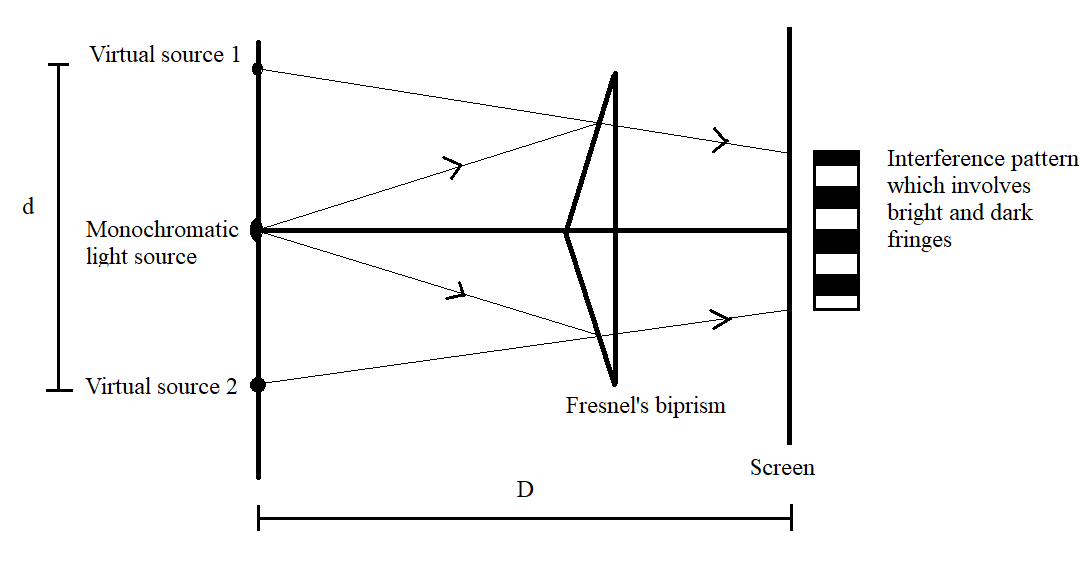
In Fresnel’s biprism experiment, when light of wavelength
A)
B)
C)
D)
Answer
496.5k+ views
Hint: Fresnel’s biprism experiment is a special case of Young’s double slit experiment. The fringe widths obtained through both the experiments have similar formulas. The order of fringe at a particular point due to a monochromatic light source can be determined by comparing its fringe width to the fringe width obtained using another monochromatic light source at the same point.
Complete answer:
Fresnel’s biprism experiment is a variation of Young’s double slit experiment. In Fresnel’s biprism experiment, two prisms which are connected through their bases are used. When monochromatic light of a particular wavelength is allowed to fall on this setup, an interference pattern involving bright and dark fringes is observed on a screen kept on the other side of the biprism. It is seen that the interference pattern is concentrated at the centre of the screen and appears to fall from two virtual sources of monochromatic light behind the prism. Thus, this experiment is similar to Young’s double slit experiment, which uses two light sources. The fringe width obtained using Fresnel’s biprism and that obtained using Young’s double slit experiment have the same formulas.

In Fresnel’s biprism experiment, the fringe width is given by
where
Let this be equation 1.
From the question, we are provided that a monochromatic light of wavelength
Let this be equation 2.
It is also given that the
where
Therefore, the fringe width of
Let this be equation 3.
Substituting equation 2 in equation 3, we have
Let this be equation 4.
Now, let us move on to the second trial, where a monochromatic light source of wavelength
Let this be equation 5.
Now, the fringe width of a fringe of a particular order
Let this be equation 6.
To determine the value of
Therefore, the order of fringe at the point
So, the correct answer is “Option B”.
Note:
In the last step, to obtain the value of
Complete answer:
Fresnel’s biprism experiment is a variation of Young’s double slit experiment. In Fresnel’s biprism experiment, two prisms which are connected through their bases are used. When monochromatic light of a particular wavelength is allowed to fall on this setup, an interference pattern involving bright and dark fringes is observed on a screen kept on the other side of the biprism. It is seen that the interference pattern is concentrated at the centre of the screen and appears to fall from two virtual sources of monochromatic light behind the prism. Thus, this experiment is similar to Young’s double slit experiment, which uses two light sources. The fringe width obtained using Fresnel’s biprism and that obtained using Young’s double slit experiment have the same formulas.

In Fresnel’s biprism experiment, the fringe width is given by
where
Let this be equation 1.
From the question, we are provided that a monochromatic light of wavelength
Let this be equation 2.
It is also given that the
where
Therefore, the fringe width of
Let this be equation 3.
Substituting equation 2 in equation 3, we have
Let this be equation 4.
Now, let us move on to the second trial, where a monochromatic light source of wavelength
Let this be equation 5.
Now, the fringe width of a fringe of a particular order
Let this be equation 6.
To determine the value of
Therefore, the order of fringe at the point
So, the correct answer is “Option B”.
Note:
In the last step, to obtain the value of
Recently Updated Pages
Master Class 9 General Knowledge: Engaging Questions & Answers for Success

Master Class 9 English: Engaging Questions & Answers for Success

Master Class 9 Science: Engaging Questions & Answers for Success

Master Class 9 Social Science: Engaging Questions & Answers for Success

Master Class 9 Maths: Engaging Questions & Answers for Success

Class 9 Question and Answer - Your Ultimate Solutions Guide

Trending doubts
Give 10 examples of unisexual and bisexual flowers

Draw a labelled sketch of the human eye class 12 physics CBSE

Differentiate between homogeneous and heterogeneous class 12 chemistry CBSE

Differentiate between insitu conservation and exsitu class 12 biology CBSE

What are the major means of transport Explain each class 12 social science CBSE

Why is the cell called the structural and functional class 12 biology CBSE




